Analysis and Design with UML
毕业设计----基于UML的图书管理系统设计论文
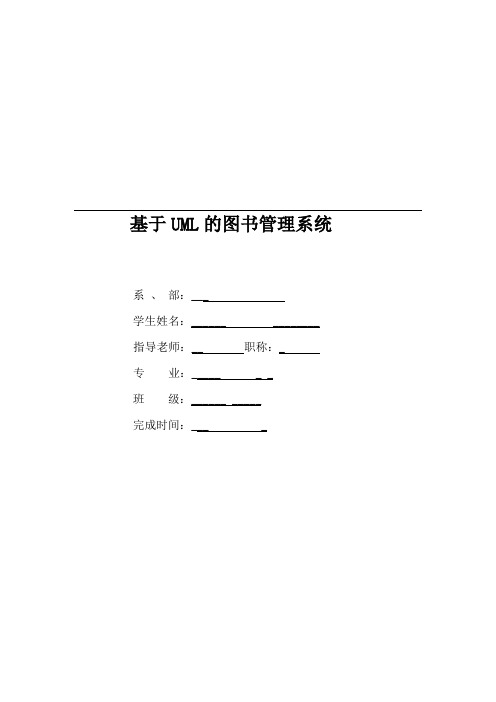
基于UML的图书管理系统系、部:___学生姓名:______ ________ 指导老师:__ 职称:_ 专业:_____ _ _班级:______ _____完成时间:___ _摘要图书管理系统是智能办公系统(IOA)的重要组成部分,该系统正以方便、快捷的优点慢慢地进入人们的生活。
它从传统的图书管理方式中彻底的解脱出来,它的设计提高了工作效率,减轻了工作人员以往繁忙的工作,减小了出错的概率,使读者可以花更多的时间在选择书和看书上,使人们有更多的时间来获取信息、了解信息、掌握信息。
本系统基于UML建模语言,对系统进行了全面的分析和设计,进行了静态和动态两方面的建模,其开发主要包括后台数据库的建立和维护以及前端应用程序的开发两个方面。
本系统采用SQL Server2005数据库作为后台数据库、 编程语言作为前台开发工具,通过对数据库技术较深入的学习和应用,以及对编程语言的系统学习,该图书管理系统主要完成了对借阅者的管理和对图书的管理,如:创建新的借阅者账户,修改借阅者的账户信息,查询,借书,预订书刊,取消预订,还书,以及添加书刊信息,编辑书刊信息,删除书刊信息等系统功能。
系统运行结果证明,本文所设计的图书管理系统可以满足借阅者、图书管理员两方面的需要,达到了设计要求。
关键词UML;图书管理;SQL Server2005;ABSTRACTThe books management system ,intelligent office system (IOA) ,is an important part of the system, with the advantages of convenient slowly go into people's life. From the traditional library management mode, it is improving thoroughly efficiency and relieving staff’s formerly busy job, reducing the error probability, so that readers can spend more time reading books and choosing. It makes people have more time to obtain information, to grasp the information.This system used UML, carries on the comprehensive analysis and design, which mainly includes building and maintaining database and the programming of the fronted application. Server SQL2005 database is the back database programming language, and is the receptionist development tool. It based on database technology in-depth study and application, the main functions are creating new borrowing account, modifying the account information, borrowing books, periodicals, reservating , canceling reservation and periodicals, adding a new species, deleting information modify books, periodicals species in the system of information system, editing books and periodicals add, delete the books information. System operation results show that the design of the library management system can satisfy the need of librarians and borrower from two aspects, It meets the design requirements.Keywords UML; library book management; SQL Server2005;目录1 引言 (1)1.1 选题背景介绍 (1)1.2 本课题研究的意义 (1)1.3 开发环境简介 (2)1.3.1 的介绍 (2)1.3.2 SQL Server 2005 概述 (3)1.3.3 IIS服务器技术 (4)2 系统分析 (5)2.1 系统分析的任务 (5)2.2 可行性分析 (5)2.2.1 技术可行性 (6)2.2.2 经济可行性分析 (6)2.2.3社会可行性分析 (6)3 需求分析 (7)3.1 功能需求分析 (7)3.1.1 系统功能模块分析 (8)3.1.2 识别参与者 (8)3.1.3 识别用例 (8)3.1.4 用例的事件流描述 (10)3.2 非功能性需求分析 (16)3.3 静态建模 (16)3.3.1定义系统对象 (16)3.3.2定义用户类界面 (17)3.3.3建立类图 (19)3.4动态行为建模 (22)3.4.1建立交互作用图 (22)3.4.2建立状态机图 (27)3.5物理模型 (28)4 系统设计 (30)4.1 总体设计 (30)4.1.1 系统目标设计 (30)4.1.2系统功能设计 (30)4.2系统功能模块设计 (30)4.3 数据库设计 (31)4.3.1概念结构设计 (31)4.3.2逻辑结构设计 (32)4.3.3物理结构设计 (33)5 系统实现 (34)5.1系统总体结构设计 (34)5.2主要模块运行 (34)6 系统测试 (37)6.1系统测试方法及步骤 (37)6.2测试用例 (37)7 结论 (39)7.1 系统开发的体会 (39)7.2 系统在调试中经常出现的问题及解决方法 (39)参考文献 (41)致谢 (42)附录 (43)1 引言1.1 选题背景介绍近年来,随着图书馆规模的不断扩大,图书数量也相应的增加,有关图书的各种信息量也成倍增加,面对着庞大的信息量,传统的人工方式管理会导致图书馆管理上的混乱,人力与物力过多浪费,图书馆管理费用的增加,从而使图书馆的负担过重,影响整个图书馆的运作和控制管理,因此,制定一套合理、有效、规范和实用的图书管理系统是很有必要的,以便对借阅者和图书资料进行集中统一的管理。
面向对象分析与设计

面向对象分析与设计在软件开发过程中,面向对象分析与设计(Object-Oriented Analysis and Design,简称OOAD)是一种重要的方法论。
通过OOAD,开发者可以将现实世界中的概念和问题转化为软件系统的结构和行为。
一、什么是面向对象分析与设计?面向对象分析与设计是一种以对象为核心的开发方法。
它强调将问题领域的实体、关系和行为抽象为对象、类和方法。
面向对象的分析阶段主要关注问题领域的需求和约束,而设计阶段则更关注如何将需求转化为可执行的软件系统。
二、面向对象分析与设计的优势1. 模块化:面向对象的方法将复杂的系统拆分为多个独立的对象,每个对象都有清晰的职责和接口。
这种模块化可以提高代码的可维护性和可复用性。
2. 继承与多态:继承是面向对象编程中的重要特性,它允许新的类继承已有类的属性和方法。
多态则允许对象在不同上下文中表现出不同的行为。
这些特性使得代码更加灵活和易于扩展。
3. 封装与信息隐藏:面向对象的方法将数据和操作封装在对象内部,外界只能通过对象的接口进行交互。
这种封装和信息隐藏可以保护数据的完整性和安全性。
4. 规范化的开发流程:面向对象的分析与设计有一套规范的开发流程,包括需求分析、概念设计、详细设计和实现等阶段。
这种流程可以提高开发效率,并减少错误和重复工作。
三、面向对象分析与设计的过程1. 需求收集与分析:在这个阶段,开发者与用户密切合作,收集和分析系统的业务需求。
通过访谈、文档分析等方法,确定系统的功能、性能和约束等方面的要求。
2. 概念设计:在概念设计阶段,开发者将业务需求转化为概念模型。
通过绘制用例图、类图、状态图等工具,描述系统的结构和行为。
3. 详细设计:在详细设计阶段,开发者将概念模型进一步细化,确定具体的类和接口。
同时,还需要考虑系统的性能、安全和可维护性等方面的问题。
4. 编码与测试:在编码阶段,开发者根据详细设计的要求,使用具体的编程语言实现系统。
9_Classes&Objects
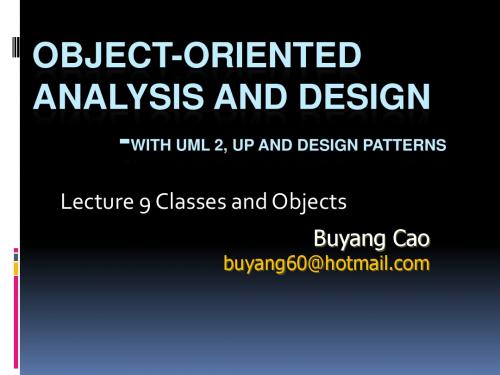
deposit(), withdraw(), setOwner().
Operations not generating state transitions (not changing attribute values): getOwner()
Messaging
Objects collaborate to perform functions of the
Abbreviated names are
harder to read and understand
invokes the corresponding operation perform the activities send the result back to the caller object.
This is quite different from procedural systems
Encapsulation
To enable user to concern
only with the services the object offer not with the structure of data hidden inside of the object.
The behavior of an object is
having the same features
Every object is an instance of exactly one class A class is a template for objects
Determines the structure of objects All objects have the same attributes, and relationships but different attribute values Allow to describe a set of features all objects must have without describing every feature for each object
系统分析与设计

22
5
RMO 案例中的事件 p.5-14
與顧客有關的重要外部事件
顧客想要檢查商品能否供貨、顧客下訂單、顧客變 更或取消訂單, 參考圖5-13
事件表格(event table)中與每個事件相關的資訊 :
每個使用案例的型錄資訊 (圖 5-15)
5
涉及部門的其他外部事件
寄送已完成的訂單、行銷部門想要寄送促銷內容給 顧客、商品部門更新型錄
事件分解技術 CRUD 分析技術 (建立, 讀取, 更新, 刪除)
Systems Analysis and Design in a Changing World, 4th Edition
11
Systems Analysis and Design in a Changing World, 4th Edition
10
5
5
在設計階段建立的模型 (圖 5-5)
3. 事件、活動與使用案例
使用案例 (use case)
Use case~activity
系統為回應使用者的要求所執行的活動 「案例」 是參與者使用系統的地方 辨識使用案例的技術 辨識使用者目標
Elementary Business Processes
基本企業流程 (EBP) 層次的目標就是使用案例 (參考圖5-6) EBP – 由一名工作人員、在一個場所執行的一項任務,目的是要回應 某個企業事件。它能夠增加可測量的企業價值,並讓系統與資料維持 一致的狀態
事件的類型
外部事件 (External event)
發生在系統之外 由外部的代理人(e.g.顧客)或參與者所啟動 , 圖5-8 事件命名: 外部代理人+動作名稱 (customer pays)
实验报告面向对象分析设计
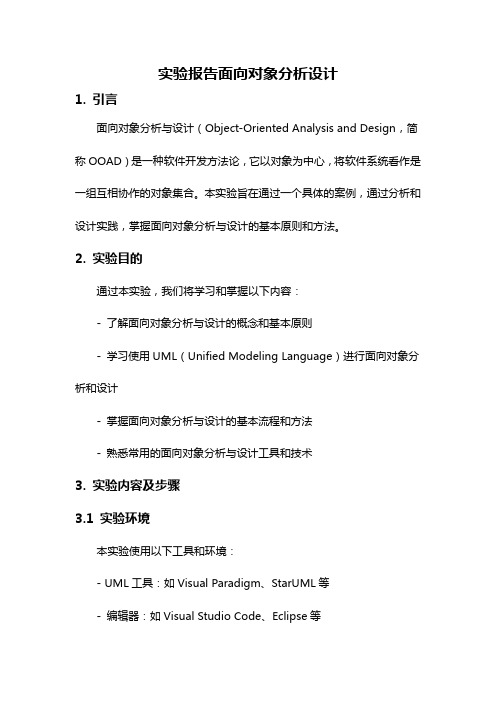
实验报告面向对象分析设计1. 引言面向对象分析与设计(Object-Oriented Analysis and Design,简称OOAD)是一种软件开发方法论,它以对象为中心,将软件系统看作是一组互相协作的对象集合。
本实验旨在通过一个具体的案例,通过分析和设计实践,掌握面向对象分析与设计的基本原则和方法。
2. 实验目的通过本实验,我们将学习和掌握以下内容:- 了解面向对象分析与设计的概念和基本原则- 学习使用UML(Unified Modeling Language)进行面向对象分析和设计- 掌握面向对象分析与设计的基本流程和方法- 熟悉常用的面向对象分析与设计工具和技术3. 实验内容及步骤3.1 实验环境本实验使用以下工具和环境:- UML工具:如Visual Paradigm、StarUML等- 编辑器:如Visual Studio Code、Eclipse等- 编程语言:Java、C++等3.2 实验步骤本实验主要分为以下几个步骤:1. 了解案例需求:首先,我们需要明确一个具体的案例,如图书馆管理系统、学生选课系统等。
本实验以图书馆管理系统为例。
2. 创建用例图:使用UML工具,根据需求,创建图书馆管理系统的用例图。
用例图描述系统的功能需求,包括用户角色、用户的需求和系统的功能。
3. 创建类图:基于用例图和需求分析,使用UML工具创建类图。
类图描述系统的静态结构,包括类和类之间的关系。
4. 创建时序图:基于用例图和类图,使用UML工具创建时序图。
时序图描述系统的动态行为,展示对象之间的交互关系和顺序。
5. 完善设计:基于用例图、类图和时序图,进一步完善系统设计。
包括类的属性和方法的设计、系统的架构设计等。
4. 实验结果与分析通过本实验,我们完成了图书馆管理系统的面向对象分析与设计。
通过用例图、类图和时序图的创建,我们清晰地描述了系统的功能需求、静态结构和动态行为。
通过系统设计的完善,我们定义了系统的架构和各个类的属性和方法。
System Analysis and Design系统分析与设计概要

Data Model
Use Case Realization in Analysis & Design
<<realizes>>
Use Case (Use-Case Model)
Use-Case Realization (Design Model)
Use Case
Sequence Diagrams
Collaboration Diagrams
Class Diagrams
從需求到類別
1
Campaign Manager
Add a new advert to a campaign
3
5: createNewAdvert() 4: selectCampaign() 3: selectClient()
5.1: addNewAdvert() 4.1: showCampaignAdverts() 3.1: showClientCampaigns()
Diagrams (類別圖)
Object
Diagrams (物件圖)
Component
Diagrams (元件圖)
Deployment
Diagrams (部署圖)
Static Diagrams
(靜態觀點)
UML First Pass
• Use case diagrams(使用案例圖)
– 描述使用者所見之系統的功能性行為.
7: readFile ( ) 5: readDoc ( )
repository : Repository
document : Document
File read( )
GrpFile
read( ) open( ) create( ) fillFile( )
uml书的参考文献

uml书的参考文献参考文献:1. Booch, G., Rumbaugh, J., & Jacobson, I. (2005). The unified modeling language user guide. Pearson Education.2. Fowler, M., Scott, K., & UML Distilled. (2004). A Brief Guide to the Standard Object Modeling Language. Addison-Wesley Professional.3. Larman, C. (2004). Applying UML and Patterns: An Introduction to Object-Oriented Analysis and Design and Iterative Development. Pearson Education.4. Ambler, S. W. (2002). The Object Primer: Agile Model-Driven Development with UML 2.0. Cambridge University Press.5. Arlow, J., & Neustadt, I. (2005). UML 2 and the Unified Process: Practical Object-Oriented Analysis and Design. Addison-Wesley Professional.6. Stevens, P., Pooley, R., & Brook, P. (2000). Using UML: Software Engineering with Objects and Components. Addison-Wesley Professional.7. Alhir, S. S. (2004). Advanced Database Projects in Access 2007: Suitable for Users of Office 2010. Prentice Hall.8. Gomaa, H. (2011). Software Modeling and Design: UML, UseCases, Patterns, and Software Architectures. Cambridge University Press.9. Schmuller, J. (2004). Sams Teach Yourself UML in 24 Hours. Sams Publishing.10. Jacobson, I., Christerson, M., Jonsson, P., & Overgaard,G. (2004). Object-Oriented Software Engineering: A Use Case Driven Approach. Addison-Wesley Professional.参考文献中提到的书籍涵盖了UML的各个方面,从初学者向导到进阶实践都有所涉及。
《软件需求分析、设计与建模》简答题样题2(含答案)

1.What is object technology? What do you perceive as object technology’s strength? It’s weakness?OOT is such a technology that facing the objective world and the question realm and using the generally thinking way of human-beings to acknowledge the nature world to describe some things.OOT fit the thinking way of human-beings and easy to protect and functions’ addition and decrease are also become more convenient. And OOT’s reusing is more strengthen.weakness2. What is UML? List at least three benefits of developing with UML.UML(Unified Modeling Language)is used to proceeding the visual model of software dense system.(1)UML can help to express things exactly.(2)UML can help programmer to write a better code.(3)UML can accelerate the procedure’s development.3.What process characteristic best fit the UML? Describe each characteristic.4.What is a use-case driven process? What is use-case? What are the benefits of use case?It is the use-case become a guidance of program.Use-case is a description of system functions.Use-case can help us to get a general impression of the determined system.5.What is system’s architecture? What is an architecture-centric Process?System’s architecture is an overall construction of a system, it include the concept, the requirements and all of the detail in implementing the project. The architecture-centric process is a process that exploit a software use the system’s architecture.6.What is iteration? What are the benefits of Iterative Development?Iteration is a way of exploiting the software that finishing the software in several steps, and it need the customer present his advices after every step in order to ensure the product can fit to the requirements of the customer’s. Iteration can ensure a lower risk in a large project.7.What are the basic principles of OO technology? Describe each in detail.Abstraction, it report those important properties connect to the applications.Encapsulation, it can cover details of implementation and is the basis of the modularity.Modularity, it break complex part into simple piecesHierarchy, it provides a method that can let the son class to get data from father class.8.What is use case model? Which artifacts can be included in a use case model?9.List three types of relationships existed between different use cases and give examples.Generalization, Include, Extend.Generalization, apples and bananas can be generalized as fruit.Include, the banana peel is included in the banana.Extend, we can eat the banana, but we can also smash it and mixed it with yogurt and drink it, drinking is an extension.10.Explain the following diagram and their elements with examples.1) Use case diagram 2) Activity diagram 3) Sequence diagram 4) Collaboration diagram5) Class diagram 6) state chart diagram 7) Deployment diagram1)2)3)4)5)6)7)11.Describe the similarities and differences between the sequence diagram and collaborationdiagram.They are both interactive diagram, but collaboration diagram don’t care about when the information be transferred.12.Define the different relationships in class diagram: dependency, association, aggregation,composition, generalization.Dependency, is a connection during two classes, one class depend another class.Association, it let a class acquire another class’s functions and attributes.Aggregation, it is the association but those two classes are in different levels, one is entity but the other one is part.Composition, it is a kind of aggregation, it demands the object that represent the entity in responsible of the life cycle of the object that represent the part.Generalization, it represents the hierarchy between two classes.13.What is a node in deployment diagram? List two different types of nodes.Node in deployment diagram always represent a device .14.Describe the extensibility mechanisms of UML.15.What is the function of Stereotypes?Give two examples of stereotypes.16.Explain the six best practices of software engineering.1)Iteration 2)Manage requirements 3)Module-basis architecture 4)visualization modeling5) software quality’s confirmation 6)Control the changes of software.17.What is RUP? How many phases are there in RUP? Describe each phase’s purpose andmilestone.It is a programming exploitation methodology which is OOT and web-basis.Inception, Elaboration, Construction, TransitionInception: Constructing the business cases of system and confirm the edge of the project.Lifecycle objective.Elaboration: Analysis the problem domain.Lifecycle architecture.Construction: Product’s exploitation.Initial operation.Transition: Ensuring the software is usable to the customer.Product release. and briefly describe the “4+1”views of architecture.Ans:Which of the four views are:Logical View which is the logical relationship around the objects,Process View which is the view that show the actions of the objects or software actions,Deployment View which is to show the relatonship between the module of the objects and Implementation View which is the software implementations.And the one view can be Use-Case View.19.What is the difference between analysis and design?The analysis focus on understanding of de problem,but the design focus on the understanding of the solution.20.Please describe the whole process of OO analysis and design with UML.Ans:1.Build the requirement model-the plan for the reqiurement2.Build the basic model-Class diagram3.Build the assistant diagram4.Design the protocol of the model5.Prototype Development21.What is a layered architecture? Give examples of typical layers.Ans:A layered architecture can be descript as the “separation of responsibility which is to say that each layer is responsible for a finite amount of work.For instance,a company may has its enterprise architecture.The layers of the manager and the layers of the employees.They have the responsibilities themselves and they have their own layers.22.What are analysis mechanisms? What are design mechanisms? Give examples.Ans:Analysis mechanisms can be a process which may run through the whole analysis.And so does the design mechanisms.For instance,a analysis mechanisms may contains Auditing, Communication and so on.23.What is an analysis class? Name and describe the three analysis stereotypes. Give examples. Boundary Classes: Behavior that involves communication with an actorEntity Classes: Behavior that involves the data encapsulated within the abstractionControl Classes: Behavior specific to a use case or part of a very important flow of events24.What is Use-case realization? What‘s your understandings about the benefit of the use-caserealization structure.Ans:The Use-case realization is a method to realize the problem that we should analyse.The use-case realization structure helps to organize the model elements needed to realize the use cases in the design model.25.Describe the steps occurred in the use-case analysis.Ans:It may contain five steps: (1)Identify Use Cases,(2)Indentify Domain Class and relationships,(3)Define the System Sequence Diagram for each use case,(4)Produce an operation,(5)Draw a sequence diagram for each use case.26.What’s the package, and why we need package?Ans:Package is a universal mechanism that organize other elements of the models together.Why we need?If a system has a lot of structures and we have to know more about the structures,then we should point to the so many elements that the systems or the structureshave.And at that time we can find that this may big a complex and hard work.So the package has been developed for this. Package is a universal mechanism that organize other elements of the models together.So we can analyse the system from the bigger layers instead of the great number of the element.27.What is a subsystem? What is an interface? How does a subsystem differ from a package? Ans: A subsystem is a coherent and somewhat independent component of a larger system.It is an element of the model,and it contains the semantics of the packages and the classes.An interface can be an operation about the subsystem.A subsystem realizes one or more interfaces that define its behavior.28.What is the purpose of describing the run-time architecture? How to model the process view? Ans:Describing the run-time architecture’s purpose is:Analyze concurrency requirements,Identify processes and threads,Identify process lifecycles, Map processes onto the implementation and Distribute model elements amongProcesses.The Process View is an “architecturally significant” slice of theprocesses and threads of the Design Model.Processes can be modeled using:1. Active classes (Class Diagrams) and Objects(Interaction Diagrams)ponents (Component Diagrams)29.What is the purpose of describing the distribution? How to model the deployment view? Ans:The purpose is to Reduce processor load.For the Special processing requirements,Scaling concerns,Economic concerns and Distributed access to the system.The Deployment View is an “architecturally significant” slice of the Deployment Model.The deployment view will contain nodes and connections.Connection lines are used to connect the nodes that will be Physical run-time computational resource,Processor node and Device node.And connections may contain Communication mechanism,Physical medium and Software protocol30.Describe the 3 typical distribution patterns, C/S , B/Sand P2P.Ans:C/S:Client/Server, in network connections pattern, besides coordinated net, but also has another form network, namely client/server net, Client/Server. In the client/server network, the server is the network core, but the client is the network foundation, the client dependence server obtains the network resource which needs, but the server provides the network for the client to resources.B/S: Browser/Server,is called as Browser/Server patterns.It is developing as the development of Internet,it is improved from the C/S.P2P: Peer-to-peer network. According to the network in the shared resource way's difference, the local area network has two kind of configurations of organization: One kind is the peer-to-peer network (), another kind is the workstation/server structure. Between peer-to-peer network's computer may correspond mutually and the shared resource (document, peripheral device and so on); But in the workstation/server structure's network may the shared resource place on special purpose computer - server (server), between workstation not mutually direct shared resource. 31.What is the difference between the process models of agile and RUP?Ans: Rational Unified Process is a whole software process,but the process models of agile may bea process in an Architecture or in part of a software.That is to say the RUP may contain the process models of agile.。
面向对象系统分析与设计教学大纲
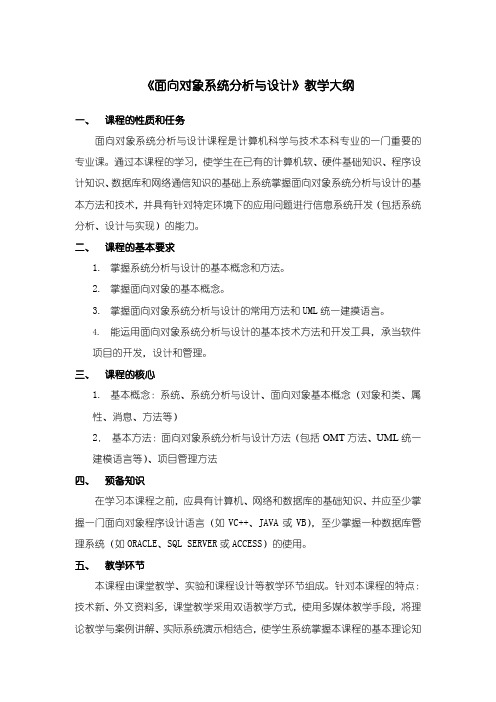
《面向对象系统分析与设计》教学大纲一、课程的性质和任务面向对象系统分析与设计课程是计算机科学与技术本科专业的一门重要的专业课。
通过本课程的学习,使学生在已有的计算机软、硬件基础知识、程序设计知识、数据库和网络通信知识的基础上系统掌握面向对象系统分析与设计的基本方法和技术,并具有针对特定环境下的应用问题进行信息系统开发(包括系统分析、设计与实现)的能力。
二、课程的基本要求1.掌握系统分析与设计的基本概念和方法。
2.掌握面向对象的基本概念。
3.掌握面向对象系统分析与设计的常用方法和UML统一建摸语言。
4.能运用面向对象系统分析与设计的基本技术方法和开发工具,承当软件项目的开发,设计和管理。
三、课程的核心1.基本概念:系统、系统分析与设计、面向对象基本概念(对象和类、属性、消息、方法等)2.基本方法:面向对象系统分析与设计方法(包括OMT方法、UML统一建模语言等)、项目管理方法四、预备知识在学习本课程之前,应具有计算机、网络和数据库的基础知识、并应至少掌握一门面向对象程序设计语言(如VC++、JAVA或VB),至少掌握一种数据库管理系统(如ORACLE、SQL SERVER或ACCESS)的使用。
五、教学环节本课程由课堂教学、实验和课程设计等教学环节组成。
针对本课程的特点:技术新、外文资料多,课堂教学采用双语教学方式,使用多媒体教学手段,将理论教学与案例讲解、实际系统演示相结合,使学生系统掌握本课程的基本理论知识以及方法和技术;实验环节中要求学生学习并熟练掌握一种或几种流行的系统建模工具、数据库和编程语言以及项目管理软件的使用;课程设计环节包括设计题目的讨论、分析、设计和实现,通过课程设计使学生将理论应用于实践,加强学生对实际问题的分析和解决能力,以及团体协作和项目管理能力。
通过这些教学环节,将学生培养成为基础理论扎实、动手能力强,并且能力全面的综合型人才。
六、教学内容(一)课堂教学内容第一章系统分析与设计概论(Introduction to System Analysis and Design)1.1系统分析与设计基本概念(What is System Analysis and Design)1.1.1 系统和信息系统(System and Information System)1.1.2 系统分析与设计(System Analysis and Design)1.1.3信息系统生命期和信息系统开发生命期(System Life Cycle and the Process of System Development)1.1.4 信息系统分析和设计的基本原则(The Principles for System Analysis and Design)1.2系统开发模型和方法(System Development Models and Methods)1.2.1 常用模型:瀑布模型(Waterfall Model)螺旋模型(Spiral Model)喷泉模型(Fountain Model)1.2.2 结构化系统分析与设计方法(Structured System Analysis and Design)1.2.3 原型法(Prototyping)1.2.4 面向对象系统分析与设计方法(Object-Oriented System Analysis and Design)1.2.5 计算机辅助软件工程(CASE, Computer-Aided Software Engineering) 第二章面向对象的基本概念(Concepts of Object-Oriented Technology)2.1 对象和类(Objects and Classes)2.2 属性、消息、方法(Attributes、Messages、Methods)2.3 关系:关联(Associations)一般-特殊(is-a)整体-部分(part-of)2.4 状态、抽象化、封装、继承(Status、Abstraction、Encapsulation、Inheritance)第三章面向对象系统分析与设计方法(Object-Oriented System Analysis and Design Method)3.1 面向对象开发过程概述(The Process of Object-Oriented System Development)3.2 OMT方法3.3 Shlaer & Mellor法3.4 Coad & Yourdon法3.5 Booch法3.6 UML统一建模语言(Unified Modeling Language)第四章面向对象编程(Object-Oriented Programming)4.1分析、设计、编程的流程(The Process of Analysis, Design and Programming)4.2分析、设计、编程的关系(The Relationship of Analysis, Design and Programming)第五章UML面向对象设计基础(Object-Oriented Design with Unified Modeling Language)5.1用户模型视图:用例图(Use Case Diagram)5.2结构模型视图:类图(Class Diagram)对象图(Object Diagram)5.3行为模型视图:序列图(Sequence Diagram)协作图(Collaboration Diagram)状态图(State Diagram)活动图(Activity Diagram)5.4实现模型视图:组件图(Component Diagram)5.5环境模型视图:展开图(Deployment Diagram)第六章UML面向对象开发(Unified Modeling Language Development Method)6.1 UML系统分析和建模(UML System Analysis and Modeling)6.2 UML系统设计和建模(UML System Design and Modeling)第七章项目管理(Project Management)7.1项目和项目管理的概念(What is a Project and Project Management)7.2 项目管理知识体系(PMBOK , Project Management Body Of Knowledge)7.3两个工具:PERT图(PERT Chart)甘特图(Gantt Chart)(二)实验1.学习并使用系统建模工具(Rational Rose、Microsoft Visio等)2.学习并运用程序设计语言进行数据库编程,程序设计语言可选择VC++、JAVA或VB,数据库可选择ORACLE、SQL SERVER或ACCESS。
UML发展历史
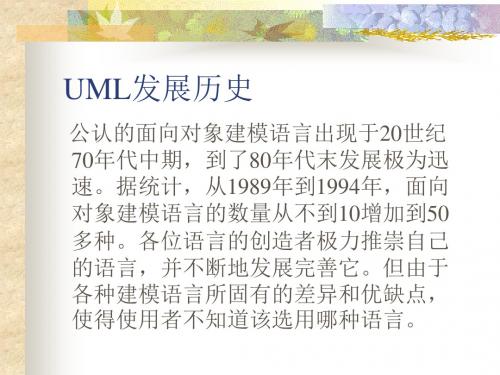
无论分析人员怎样在开始进行调查研究与 分析,都不可能对未来系统的一切需求都 定义得完整无缺。往往在以后的设计阶段 或编码阶段,才发现原来对系统的需求定 义必须进行修改或补充。越在后期发现问 题,越难补救,会导致大量费用的投入, 并可能降低软件的质量。
面向对象的软件开发过程
面向对象的软件开发过程强调开发阶段的 无缝集成,例如,系统分析员和设计人员, 通常要往返进行分析和设计,为程序设计 人员提供坚实的基础。程序设计人员反过 来也要与分析人员和设计人员交互,共享 重要的见解、修改设计、充实代码。这种 方法的优点是随着对问题理解的深入,项 目小组能及时发现问题,建立起更完善的 系统。缺点是分析和设计时间长,不能很 快看到代码。
UP的软件开发过程
UP的软件开发过程被划分为四个阶段: 初始阶段 细化阶段 构建阶段 移交阶段
初始阶段
探讨软件开发的必要性和可行性;捕获 基本需求以界定系统范围;识别关键任 务。
细化阶段
细化用例,确定系统的基本架构 。细化 包括分析、设计、编码和测试文件。通 过迭代的方法建造软件系统。每个迭代 包括5个核心工作流,每个迭代将得到一 个更准确的接近未来系统的模型。
Learn efficiently by following a refined presentation
通过一套精细的表述方式进行卓有成效的 学习
Learn from a realistic exercise 通过符合实际的例子辅助学习 Translate to code 学会把设计转换成代码 Design a layered architecture 设计出一种分层的系统体系结构 Design a framework 设计出系统框架
System Analysis and Design系统分析与设计概要

DocumentList
GraphicFile File
FileList
Deployment diagram
Window95
Windows95
Windows95
¹®¼ °ü¸® Ŭ¶óÀ̾ ðÆ ®.EXE
Windows NT
¹®¼ °ü¸® ¿£Áø.EXE
Windows NT
¹®¼ °ü¸® ¾ ÖÇø´
Sequence
Diagrams (順序圖)
Collaboration
Diagrams (合作圖)
Dynamic Diagrams
(動態觀點)
Statechart
Diagrams (狀態圖)
Use-Case Diagrams (使用案例圖)
Models
Activity Diagrams (活動圖)
Class
Class diagram
Actor B
FileMgr
fetchDoc( ) sortByName( )
DocumentList
add( ) delete( )
FileList fList
add( ) delete( )
1
Document
name : int docid : int numField : int
1: Doc view request ( )
mainWnd : MainWnd
L
user : Clerk
2: fetchDoc( )
4: create ( ) 8: fillFile ( )
gFile : GrpFile
fileMgr : FileMgr
3: create ( ) 6: fillDocument ( )
《UML面向对象分析、建模与设计》教学大纲
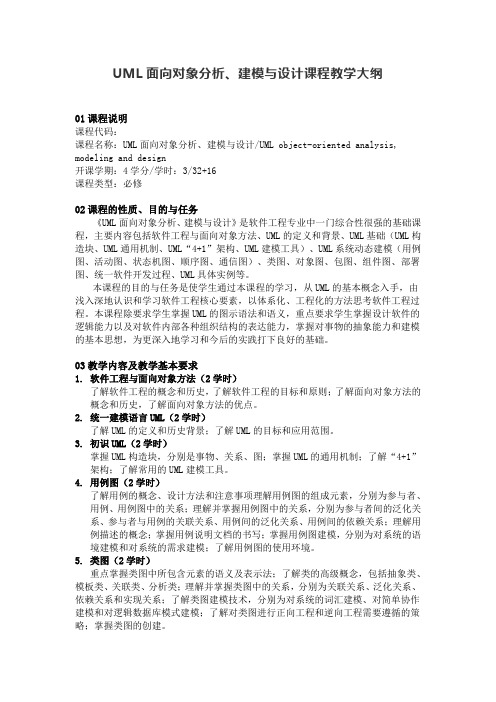
UML面向对象分析、建模与设计课程教学大纲01课程说明课程代码:课程名称:UML面向对象分析、建模与设计/UML object-oriented analysis, modeling and design开课学期:4学分/学时:3/32+16课程类型:必修02课程的性质、目的与任务《UML面向对象分析、建模与设计》是软件工程专业中一门综合性很强的基础课程,主要内容包括软件工程与面向对象方法、UML的定义和背景、UML基础(UML构造块、UML通用机制、UML“4+1”架构、UML建模工具)、UML系统动态建模(用例图、活动图、状态机图、顺序图、通信图)、类图、对象图、包图、组件图、部署图、统一软件开发过程、UML具体实例等。
本课程的目的与任务是使学生通过本课程的学习,从UML的基本概念入手,由浅入深地认识和学习软件工程核心要素,以体系化、工程化的方法思考软件工程过程。
本课程除要求学生掌握UML的图示语法和语义,重点要求学生掌握设计软件的逻辑能力以及对软件内部各种组织结构的表达能力,掌握对事物的抽象能力和建模的基本思想,为更深入地学习和今后的实践打下良好的基础。
03教学内容及教学基本要求1.软件工程与面向对象方法(2学时)了解软件工程的概念和历史,了解软件工程的目标和原则;了解面向对象方法的概念和历史,了解面向对象方法的优点。
2.统一建模语言UML(2学时)了解UML的定义和历史背景;了解UML的目标和应用范围。
3.初识UML(2学时)掌握UML构造块,分别是事物、关系、图;掌握UML的通用机制;了解“4+1”架构;了解常用的UML建模工具。
4.用例图(2学时)了解用例的概念、设计方法和注意事项理解用例图的组成元素,分别为参与者、用例、用例图中的关系;理解并掌握用例图中的关系,分别为参与者间的泛化关系、参与者与用例的关联关系、用例间的泛化关系、用例间的依赖关系;理解用例描述的概念;掌握用例说明文档的书写;掌握用例图建模,分别为对系统的语境建模和对系统的需求建模;了解用例图的使用环境。
UML面向对象的分析与设计

定义用例
定义领域模型
定义交互图
定义设计类图
24
OOAD
OOA/D的简单示例-骰子游戏
• 软件模拟游戏者掷两个骰子,如果总点数是7 则赢得游戏,否则为输
25
OOAD
定义用例(需求阶段)
定义用例
定义领域模型
定义交互图
定义设计类图
• 需求分析可能包括人们使用应用的情节或场景, 这些情节或场景可以被编写成用例。
由用例描述可初步得出领域模型
Player
1
name
1
Plays 1
DiceGame
1
Rolls
2
Die
faceValue
2
Includes
图1-3 骰子游戏的局部领域模型
28
OOAD 分配对象职责并绘制交互图(OOD)
定义用例
定义领域模型
定义交互图
定义设计类图
• OOD关注的是软件对象的定义——它们的职责 和协作
• 顺序图(sequence diagram,UML的一种交互 图)是描述协作的常见表示法。
• 顺序图展示出软件对象之间的消息流,和由消 息引起的方法调用。
29
OOAD 骰子游戏:游戏者请求掷(两个)骰子。系统展示结果:如 果骰子总点数是7,则游戏者赢,否则游戏者输。
顺序图动态的展示了系统如何实现用例, 展示了对象的职责和协作
• 培养OO开发的重要能力:识别领域对象,设 计软件对象(为软件对象分配职责)
7
OOAD
资源: 教材及参考书
8
OOAD
教材结构安排
•教材编排特色: •不像传统教材按主题编排 •而是遵循UP(统一过程)中”Iterative”(迭代)思 想。
uml_tutorial

So UML can be described as a general purpose visual modelling language to visualize, specify, construct and document software system. Although UML is generally used to model software systems but it is not limited within this boundary. It is also used to model non software systems as well like process flow in a manufacturing unit etc. UML is not a programming language but tools can be used to generate code in various languages using UML diagrams. UML has a direct relation with object oriented analysis and design. After some standardization UML is become an OMG (Object Management Group) standard.
Tutorials Point, Simply Easy Learning
UML Tutorial
UML is a standard language for specifying, visualizing, constructing, and documenting the artifacts of software systems. UML was created by Object Management Group and UML 1.0 specification draft was proposed to the OMG in January 1997. This tutorial gives an initial push to start you with UML. For more detail kindly check /uml UML is a standard language for specifying, visualizing, constructing, and documenting the artifacts of software systems. UML was created by Object Management Group (OMG) and UML 1.0 specification draft was proposed to the OMG in January 1997. OMG is continuously putting effort to make a truly industry standard.
UML系统分析与设计

2021/1/23
类图与对象图的基本概念
1、类图的含义
在类图中,具 体来讲它一共包含 了以下几种模型元 素,分别是:类、 接口、依赖关系、 泛化关系、关联关 系以及实现关系。
类图可以创建 约束、注释和包等。
2021/1/23
类图与对象图的基本概念
2021/1/23
用例描述的是参与者和系统边界之间的交互操作 ——系统本身是一个黑盒子,带有外部才能看到的接 口; 为了使得系统更容易开发和理解,用例细节是用 自然语言编写的——用例是不严密的; 需求阶段所得到的模型并不能全面描述系统,开 发人员仅通过这些模型也无法全面理解问题。
2021/1/23
角色的名称应该是名词或名词短语,以解释对 象是如何参与关系的。
2021/1/23
指有多少对象可以参与该关联。 可以表达一个取值范围、特定值、无限定的范
围或一组离散值。 格式:“minimum..maximum” (均为Int
型)。 赋给一个端点的多重性表示该端点可以有多少
个对象与另一个端点的一个对象关联。
2021/1/23
组合关系示 例
➢ 1 名称 ➢ 2 角色 ➢ 3 多重性
2021/1/23
使用一个动词或动词短语来命名关联。 清晰而简洁地说明对象间关系。 关联的名称并不是必需的。 可以前缀或后缀一个指引阅读方向的方向指示
符,以消除歧义。
2021/1/23ห้องสมุดไป่ตู้
关联关系中一个类对另一个类所表现出来的职 责。
2021/1/23
➢ 1 依赖关系(Dependency) ➢ 2 泛化关系(Generalization) ➢ 3 关联关系(Association) ➢ 4 实现关系(Realization)
8_ArchitecturalAnalysis
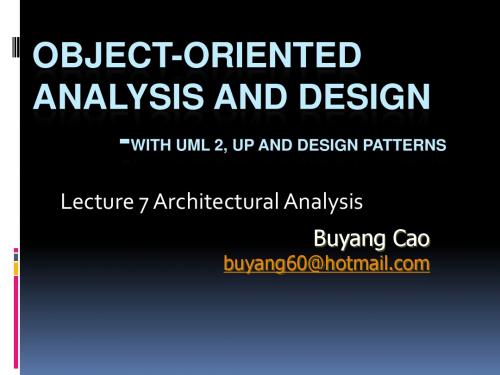
What Is a Package?
A package is a general-purpose mechanism
for organizing elements into groups. It is a model element that can contain other model elements.
Layer 6
Layer 5
Transport
Network
Layer 4
Layer 3
Data Link
Physical
Layer 2
Layer 1
Layering Considerations
Level of abstraction
Software management
Process View
Deployment View
System engineering
System integrators
Performance, scalability, throughput
System topology, delivery, installation, communication
PatБайду номын сангаасerns and Frameworks
Pattern
Provides a common solution to a common
Analysis/Design pattern
problem in a context
Provides a solution to a narrowly-scoped
Architecture Analysis Architect Define a Candidate Architecture [Inception Iteration (Optional)] Perform Architectural Synthesis
- 1、下载文档前请自行甄别文档内容的完整性,平台不提供额外的编辑、内容补充、找答案等附加服务。
- 2、"仅部分预览"的文档,不可在线预览部分如存在完整性等问题,可反馈申请退款(可完整预览的文档不适用该条件!)。
- 3、如文档侵犯您的权益,请联系客服反馈,我们会尽快为您处理(人工客服工作时间:9:00-18:30)。
The UML is the standard language for visualizing, specifying, constructing, and documenting the artifacts of a software-intensive system(UML是一种用于软件产品的文档化、结构
UML stands for Unified Modeling Language(统一建模语言) The UML combines the best of the best from UML结合了最好的
– –
What is the UML? UML是什么?
–
–
Data Modeling concepts 数据建模概念(Entity Relationship Diagrams实体-关系图) Business Modeling 事务建模(work flow工作流) Object Modeling 对象建模 Component Modeling部件建模
学生
Billing System
支付系统
Page 14
Байду номын сангаас
Copyright ?1997 by Rational Software Corporation
Use Cases
用例
A use case is a pattern of behavior the system exhibits
一个用例 是一个系统所展示的行为的模板
Copyright ?1997 by Rational Software Corporation
Putting the UML to Work
UML实例
The ESU University wants to computerize their registration system(ESU大学要用电脑实现一个注册系统)
Visual Modeling is modeling using standard graphical notations
可视化建模是利用标准的图 像符号的建模过程
Page 3
Computer System 计算机系统
Copyright ?1997 by Rational Software Corporation
application partitioning 应用系统分割 Scenarios 脚本
Use Cases 用例
ActiveX/COM Microsoft
CORBA OMG Business Process 事务过程
Page 11
Copyright ?1997 by Rational Software Corporation
–
The Registrar sets up the curriculum for a semester
为每个学期设置课程:一门课可能有多个课程申请者
–
One course may have multiple course offerings Students select 4 primary courses and 2 alternate courses
Actors
参与者
An actor is someone or some thing that must interact with the system under development
参与者是那些必须与这个待开发系统交互动作的人或事
Registrar
注册者
Professor
教授
Student
Business Logic
商务逻辑
(C++, Java)
Database Server
数据库服务器
(C++ & SQL)
独立于实现的语言之外建您的系统
Page 7 Copyright ?1997 by Rational Software Corporation
Model your system independent of implementation language
Visual Modeling Promotes Reuse
可视化建模可以促进软件复用
Multiple Systems 多个系统
Reusable Components
可复用的部件
Copyright ?1997 by Rational Software Corporation
Page 8
支付系统--从注册处获得付款信息
Maintain Curriculum
Request Course Roster
Maintain Schedule
Page 15
Copyright ?1997 by Rational Software Corporation
Analysis and Design with UML
用UML分析与设计
Page 1 Copyright ?1997 by Rational Software Corporation 译者: Guide Soft Co.,ltd.
Agenda
提要
Benefits of Visual Modeling(可视化建模概述) 进入
UML Supports Application Development
UML支持应用开发
Objects 对象 ORDBMS Oracle数据库
Business Objects 事务对象
Relationships 关系 large scale system 大规模系统
Classes 类 Components组件 Microsoft
Use visual modeling to analyze and design your application
Page 5 Copyright ?1997 by Rational Software Corporation
Visual Modeling Manages Complexity
可视化建模可以管理系统的复杂性
Page 4
Copyright ?1997 by Rational Software Corporation
Visual Modeling is a Communication Tool
可视化建模是一种通信工具
Use visual modeling to capture business objects and logic 和利 的利 逻用 应用 辑可 用可 视 系视 化 统化 建 建 模 模 获 分 取 析 事 和 务 设 对 计 象 你
教授们可以得到他们的课程的申请者名单
–
Page 13
Users of the registration system are assigned passwords which are Copyright ?1997 by Rational Software Corporation used at logon validation(使用者经批准后可以得到密码)
利用“交互图”阐述用例 的实现
–
Represent a static structure of a system using class diagrams
利用“类图”描述系统的静态结构
–
Model the behavior of objects with state transition diagrams
History of the UML(UML的历史) 进入 Visual Modeling with UML(用UML进行可视化建模) 进入
The Rational Iterative Development Process(合理的迭代过 程) 进入
Copyright ?1997 by Rational Software Corporation Page 2
– –
Students may use the system to add/drop courses for a period of time after registration(注册后一段时间里学生可以增减课程) Professors use the system to receive their course offering rosters
化、说明与具体化的标准语言)
It can be used with all processes, throughout the development life cycle, and across different implementation technologies(它可以用于开发生命周期的所有过程)
What is Visual Modeling?
何谓“可视化建模”
Order 合同 Item 条款 Ship via 船运
Modeling captures essential parts of the system. 系统建模抓取的要点部分
Dr. James Rumbaugh
Business Process 商务过程
利用“状态图”给对象的行为建立模型
–
Reveal the physical implementation architecture with component & deployment diagrams (利用“组件图”和“配置图”显示物理结构
)
–
Page 12
Extend your functionality with stereotypes(利用类别扩充功能)
•
每个学生选修4门主课和2门辅课
